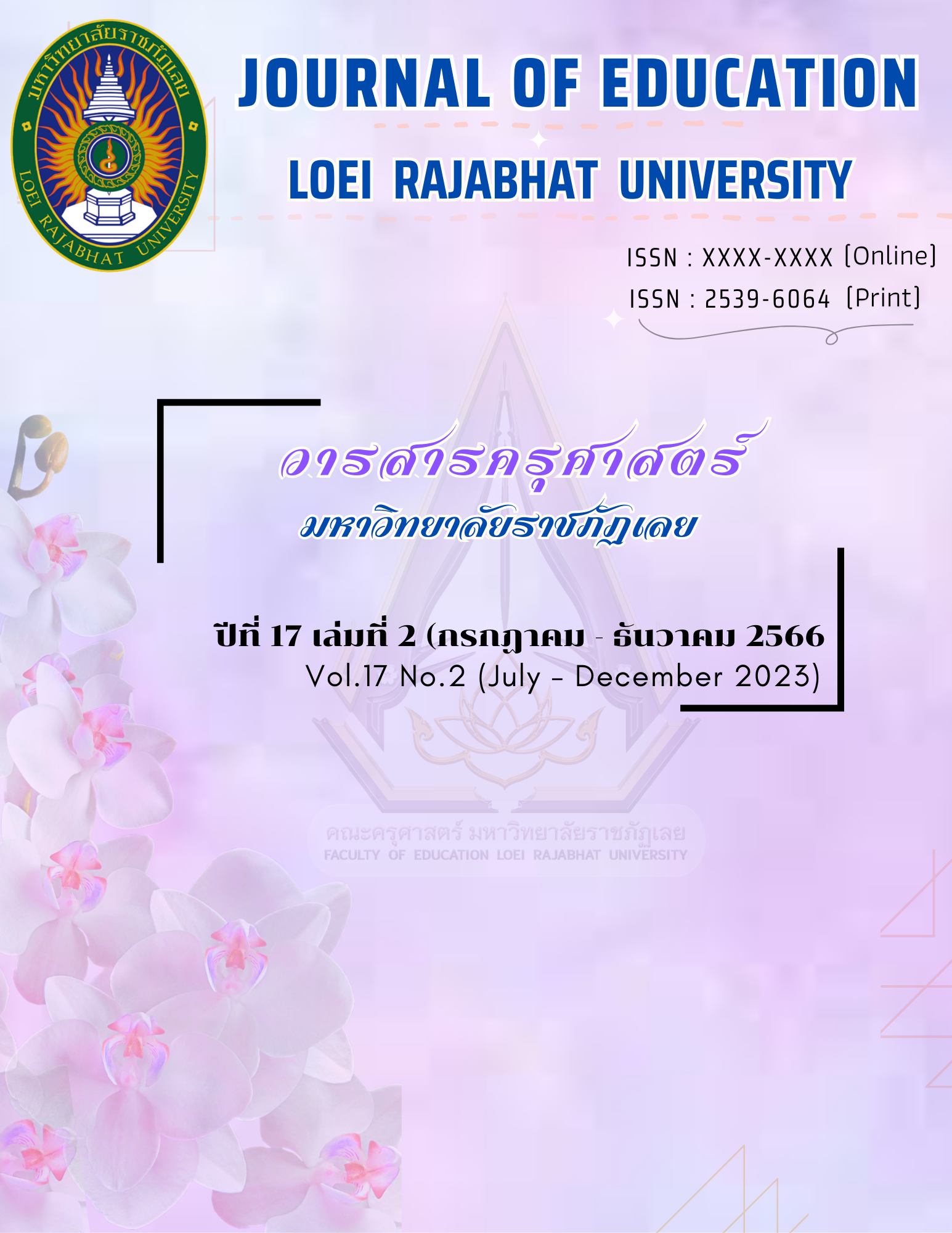ผลการใช้แชทบอทช่วยในการจัดการเรียนรู้แบบห้องเรียนกลับด้าน สำหรับนักเรียนชั้นมัธยมศึกษาปีที่ 5
คำสำคัญ:
แชทบอท, ห้องเรียนกลับด้าน, วิทยาการคำนวณ, ผลสัมฤทธิ์ทางการเรียนบทคัดย่อ
การวิจัยนี้มีวัตถุประสงค์เพื่อ 1) เพื่อพัฒนาและหาคุณภาพของแชทบอทสำหรับช่วยในการจัดการเรียนรู้แบบห้องเรียนกลับด้าน รายวิชาเทคโนโลยี (วิทยาการคำนวณ) เรื่อง การใช้สูตรในโปรแกรม Microsoft Excel เบื้องต้น สำหรับนักเรียนชั้นมัธยมศึกษาปีที่ 5 โรงเรียนเลยอนุกูลวิทยา อำเภอเมืองเลย จังหวัดเลย
2) เพื่อเปรียบเทียบผลสัมฤทธิ์ก่อนเรียนและหลังเรียนของผู้เรียนที่ใช้แชทบอทสำหรับช่วยในการจัดการเรียนรู้แบบห้องเรียนกลับด้าน 3) เพื่อศึกษาความพึงพอใจของผู้เรียนหลังจากที่ได้เรียนด้วยแชทบอทสำหรับช่วยในการจัดการเรียนรู้แบบห้องเรียนกลับด้าน กลุ่มตัวอย่างที่ใช้ในการวิจัย คือ นักเรียนชั้นมัธยมศึกษาปีที่ 5 โรงเรียน
เลยอนุกูลวิทยา อำเภอเมืองเลย จังหวัดเลย จำนวน 27 คน เครื่องมือที่ใช้ในการวิจัยได้แก่ 1) แชทบอท
2) แบบทดสอบวัดผลสัมฤทธิ์ 3) แบบประเมินความพึงพอใจ ผลวิจัยพบว่า 1) คุณภาพของระบบจัดการเรียนรู้แบบห้องเรียนกลับด้านโดยใช้แชทบอท เรื่อง การใช้สูตร Excel เบื้องต้น มีคุณภาพโดยรวมอยู่ในระดับมากที่สุด 2) ผลการเปรียบเทียบผลสัมฤทธิ์ก่อนเรียนและหลังเรียนด้วยแชทบอทสำหรับช่วยในการจัดการเรียนรู้แบบห้องเรียนกลับด้าน กลุ่มตัวอย่างมีผลสัมฤทธิ์หลังเรียนสูงกว่าก่อนเรียน อย่างมีนัยสำคัญทางสถิติที่ 0.05 3) ความพึงพอใจของผู้เรียนหลังจากที่ได้เรียนโดยแชทบอทสำหรับช่วยในการจัดการเรียนรู้แบบห้องเรียนกลับด้าน ภาพรวมอยู่ในระดับมากที่สุด
เอกสารอ้างอิง
กรรณิการ ดิษชกรร. (2565). การจัดการเรียนรูหองเรียนกลับดานโดยใช Google site ในรายวิชาวอลเลยบอลของนักเรียนชั้นมัธยมศึกษาปที่ 2 โรงเรียนสรรพวิทยาคม. การบริหารจัดการและนวัตกรรมท้องถิ่น, 4 (4), 13-27.
จักรพันธ์ สาตมุณี, ภคพล สุนทรโรจน์, คัชรินทร์ ทองฟัก และพงษ์กัมปนาท แก้วตา. (2564). การพัฒนาระบบสารสนเทศเพื่อส่งเสริมการท่องเที่ยวผ่านระบบแอปพลิเคชัน Line Chatbot ในจังหวัดพิษณุโลก. วารสารการบัญชีและการจัดการ มหาวิทยาลัยมหาสารคาม. 13(1), 100-111.
จตุรงค์ จิตติยพล และพงษ์ศักดิ์ ดรพินิจ. (2565). การพัฒนาระบบสารสนเทศเพื่อการเรียนรู้คำศัพท์เครือข่ายคอมพิวเตอร์ผ่านแอปพลิเคชัน Line Chatbot. วารสารสหวิทยาการวิจัยและวิชาการ.
(4), 607-618.
ธนกร สายปัญญา. (2565). แชทบอทสำหรับการจัดการเรียนรู้แบบผสมผสาน เพื่อพัฒนาการออกแบบ
อินโฟกราฟิก. วารสารวิชาการครุศาสตร์อุตสาหกรรม พระจอมเกล้าพระนครเหนือ. 13(3), 125-134.
บุญชม ศรีสะอาด. (2549). การวิจัยเบื้องต้น (พิมพ์ครั้งที่ 7). สุวีริยาสาส์น.
พระราชบัญญัติการศึกษาแห่งชาติ พุทธศักราช 2542. (2542, 19 สิงหาคม). ราชกิจจานุเษกษา. เล่ม 116
ตอน 74 ก. หน้า 1-22.
พิชญะ พรมลา และสรเดช ครุฑจ้อน. (2563). ผลการใช้แชทบอทช่วยในการจัดการเรียนรู้แบบผสมผสานสำหรับผู้เรียนระดับประกาศนียบัตรวิชาชีพในสถานศึกษาสังกัดสถาบันการอาชีวศึกษาภาคตะวันออกเฉียงเหนือ 1. วารสารครุศาสตร์อุตสาหกรรม, 19 (2), 100-109.
มนต์ชัย เทียนทอง. (2554). การออกแบบและพัฒนาคอร์สแวร์สำหรับบทเรียนคอมพิวเตอร์ช่วยสอน. สถาบันเทคโนโลยีพระจอมเกล้าพระนครเหนือ.
รัตนาภรณ์ เชยชิต และอรนุช ลิมตศิริ. (2565). การศึกษาผลสัมฤทธิ์ทางการเรียนและความพึงพอใจที่มีต่อรายวิชาภาษาอังกฤษด้วยระบบตอบกลับข้อความอัตโนมัติ (Chatbot). วารสารการบริหาร
นิติบุคคลและนวัตกรรมท้องถิ่น, 8 (11), 1-10.
วิจารณ์ พานิช. (2556). ครูเพื่อศิษย์สร้างห้องเรียนกลับทาง (พิมพ์ครั้งที่ 2). เอส.อาร์. พริ้นติ้ง แมสโปรดักส์ จำกัด.
ศรราม สุขสำราญ และ กรวิภา สรรพกิจจำนง. (2564). การพัฒนาผลสัมฤทธิ์ทางการเรียนวิชาวิทยาการคำนวณ เรื่อง การจัดการข้อมูลของนักเรียนชั้นมัธยมศึกษาปีที่ 5 โดยใช้หนังสืออิเล็กทรอนิกส์ชุด เทคโนโลยีการจัดการข้อมูล. Journal of Roi Kaensarn Academe, 7 (3), 152-163.
สำนักงานคณะกรรมการการศึกษาขั้นพื้นฐาน กระทรวงศึกษาธิการ. (2560). มาตรฐานการเรียนรู้และตัวชี้วัด กลุ่มสาระการเรียนรู้คณิตศาสตร์ วิทยาศาสตร์ และสาระภูมิศาสตร์ ในกลุ่มสาระการเรียนรู้สังคมศึกษา ศาสนา และวัฒนธรรม (ฉบับปรับปรุง พ.ศ.2560) ตามหลักสูตรแกนกลางการศึกษา
ขั้นพื้นฐาน พุทธศักราช 2551. โรงพิมพ์ชุมนมสหกรณ์การเกษตรแห่งประเทศไทย จํากัด.
สำนักงานคณะกรรมการการศึกษาขึ้นพื้นฐาน กระทรวงศึกษาธิการ. (2560). ตัวชี้วัดและกลุ่มสาระการเรียนรู้วิทยาศาสตร์ (ฉบับปรับปรุง พ.ศ.2560) ตามหลักสูตรแกนกลางการศึกษาขั้นพื้นฐาน พุทธศักราช 2551. โรงพิมพ์ชุมนมสหกรณ์การเกษตรแห่งประเทศไทย จํากัด.
อภิชัย ตระหง่านศรี. (2565). การพัฒนาระบบสนทนาอัตโนมัติเพื่อแสดงข้อมูลการเรียนผ่านไลน์แชทบอท. สหวิทยาการสังคมศาสตร์และการสื่อสาร, 6 (2), 127-138.
Bansal H., Khan R.. (2018). A review paper on human computer interaction International Journal of Advanced Research in Computer Science and Software Engineering, 8 (4), 53-56.
Bergmann, J., & Sams, A. (2012). Flip Your Classroom: Reach Every Student in Every Class Every Day. International Society for Technology in Education.
Fryer, L. K., Nakao, K., & Thompson, A. (2019). Chatbot learning partners: Connecting learning experiences, interest and competence. Computers in human Behavior,
, 279-289.
ดาวน์โหลด
เผยแพร่แล้ว
รูปแบบการอ้างอิง
ฉบับ
ประเภทบทความ
สัญญาอนุญาต

อนุญาตภายใต้เงื่อนไข Creative Commons Attribution-NonCommercial-NoDerivatives 4.0 International License.
เนื้อหาและข้อมูลในบทความที่ตีพิมพ์ในวารสารครุศาสตร์ มหาวิทยาลัยราชภัฏเลย ถือเป็นความคิดเห็นและความรับผิดชอบของผู้เขียนบทความโดยตรง กองบรรณาธิการวารสารไม่มีส่วนในความคิดเห็นและความรับผิดชอบใดที่เกี่ยวข้องกับบทความดังกล่าว ทั้งนี้ บทความที่ได้รับการตีพิมพ์ในวารสาร ฯ ถือเป็นลิขสิทธิ์ของวารสาร







